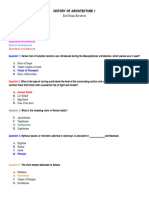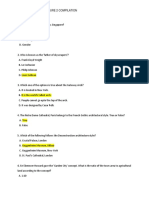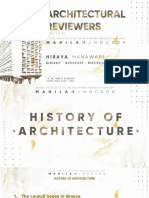Roman Art Outline: Historical Background
Roman Art Outline: Historical Background
Uploaded by
charliegonzalez217Copyright:
Available Formats
Roman Art Outline: Historical Background
Roman Art Outline: Historical Background
Uploaded by
charliegonzalez217Original Title
Copyright
Available Formats
Share this document
Did you find this document useful?
Is this content inappropriate?
Copyright:
Available Formats
Roman Art Outline: Historical Background
Roman Art Outline: Historical Background
Uploaded by
charliegonzalez217Copyright:
Available Formats
Roman Art outline
Period: 6 Chapter:7 Time period: 753 B.C.E to 500 C.E. 753 B.C.E. :Legendary founding of rome by romulus and remus 509 B.C.E.- 27 B.C.E. :Roman Republic 27 B.C.E.- 192 C.E. :Early Roman Empire 192 C.E-410 C.E. :Late Roman Empire
HISTORICAL BACKGROUND:
I. Founding of rome a. Founded by romulus and remus b. Early civilization was ruled by kings c. They had been abolished and replaced with a senate d. Established a democracy of selected men II. Time line of rome a. In 211 BCE, the greek colony of syrcruse in sicily was annexed. b. In 146 BCE rome had in taked greece. c. Civil war in the late republic caused a power vaccum that was filled by Octavian, later referred Augustus caesar who became empirior 27B.C.E. d. In 27 B.C.E. from that time rome was ruled by a series fo emperors. e) It was sacked in 410 C.E. f) Volcanic ash from mount vesuvius had covered pompeii, in 79 C.E.
g) The findings of fortune that changed historical understanding of rome had come to start in 1748. III. The selling and artistic life a) The sales of artist had occured to the most wealthiest individuals. 1. The wealthy customers had been known to spend plientiful on themselves, including their homes. 2. They had also an emotion to dedicate to society for "general good" (including public projects).
INNOVATIONS IN ROMAN ARCHITECTURE:
I. The formation of civilization a) The romans had created great roads with massive aqueducts as a way of connecting the empires to the cities, including massive arenas. b) The temples that were created as civic pride and places of worship to their gods. II. The formation of achitecture a) The romans knew the potential of creating arches. 1. Arches could span vast space. 2. Arches do not need such a consistant support of the post-and-lintel system. 3. Mortar (a receptacle of hard material) is not needed because the shape of the arch takes care of all the support. III. Structures in architecture a) Barrel vault: arches that could be extended in shape and form a consistant tunnel like structure. b) Coffers: to prevent the concrete ceilings from cracking, they had carved desines into the ceilings to reduce the weight. c) Famous buildings possible from the creation of arches. 1. Pont du Gard (16 B.C.E.) 2. Colosseum ( 72-80 C.E.) 3. Pantheon (118-225 C.E.) IV. Using concrete
a) Initially was used as filler in buildings, then as main support element. b) Was used for many of romes oversized buildings. c) Romans thought concrete was displeasing. 1. They believed it was unattractive to the eye. 2. It was high on flexibility and low on cost. d) All concrete buildings were cloaked in other materials for appearance.
CHARACTERISTICS OF ROMAN ARCHITECTURE:
I. Atrium a) An atrium was a roman courtyard with one entrance. b) It consisted of a impluvium to capture the rain water that feel upon the atrium. c) The atrium also consisted of radiated cubiculas ( private bedrooms that had no windows) which the peoples studies or living rooms were deeper into the homes). II. Marketing a) The center of the roman business world was the Forum. b) The focus of a forum was a temple deticated to the locals favorite god. 1. They believed that their god needed to be worshiped and appleased. c) Around the sides of the forum were bath houses, markets, and administrative buildings that dealt with their day essentials. III. Columns a) Columns were raised on larger pedestals to make the viewer smaller in size. 1. Composite columns had a mix between Ionic(volute) and corinthian (leaf). 2. Tuscan columns were with a style of doric capitals. IV. Greek Impact a) Greek architecture had major influence upon rome through history. b) There are adaptations of the greek influence. 1. The entrance was indicated by a flight of stairs. 2. The walls of the the cella had been extended toward the enguaged columns
which made the interior larger.
MAJOR WORKS OF ROMAN ARCHITECTURE:
I. House of the vettii a) Time frame: second century B.C.E.-C.E. b) Location: Pompeii, Italy. II. Maison Carree. a) Time frame: first century C.E. b) Location: Nimes, France. III. Pont du Guard a) Time frame: 16th century B.C.E. b) Location: Nimes, France IV. The Colosseum. a) Time frame: 72-80th centurys C.E. b) Location: Rome. V. Market of Trajan. a) Time frame: 100-112th century C.E. b) Location: Rome. VI. Pantheon. a) Time frame: 118-125th century C.E. b) Location: Rome VII. Hadrians Villa. a) Time frame: 125-128th century C.E. b) Location: Tivoli, Italy VIII. Arch of Constantine. a) Time frame: 312-315th ceturys C.E. b) Location: Rome, Italy
IX. Aula Palatina. a) Time frame: Early 4th century C.E. b) Location: Trier, Germany
INNOVATIONS IN ROMAN PAINTING:
I. Interior design. a) The interior wall paintings of different kinds were created to make up for nonwindow cubiculas. 1. Mythological 2. Landscapes 3. City plazas 4. Encaustics ( lively individual portraits of the diceased) b) Mosaics were artifacts that were floor decorations. 1. To keep their feet cool in the summer. II. Methods and technique of arts that were used a) Linear perspective b) Vanishing Points c) Atmospheric perspective d) Foreshortening III. Characteristics of roman paintings a) There are four pompeian styles in Roman history 1. 1st: Painted rectangular squares meant to resemble marble facing. 2. 2nd: large mythological scenes and/ or landscapes dominating the wall surface. 3. 3rd: Small scenes set in a field of color and framed by delicate columns of tracery. 4. 4th: Which is style combined elements from the three previous mentioned. IV. Major Works Of Roman Painting (60-50 B.C.E.) a) Dionysiac Mystery Frieze; pompeii
b) Fresco; pompeii c) Villa of Mysteries; pompeii d) Still life with peaches, Fresco; from herculaneum; national archiological museum, naples. e) Ixion room; fresco, pompeii
INNOVATIONS IN ROMAN SCULPTURE:
I. Roman sculpture evolution a) Commemorative sculptures evolved through the creations over time of battle victories. 1) To play as a idol to each of their victories to be remembered over generations. II. historical examples a) The arch of Constantine b) The column of Trajan III. Characteristics of roman sculpture. a) The styles of sculptures in roman art, broadly follows as an evolution through the eras of the roman historys. IV. Republican Sculpture a) There are characteristics and reasoning behind republican sculpture. 1. Veristic sculptures are strikingly realistic, with the age of sittering was seemed to be enhanced. 2. Idealism portrays the valued virtues that include wisdom, determination, with experience that these works possess. 3. The body sculptures occasionally were classifing valor with strength. V. Major Works of Roman Sculpture a) Man of the roman republic 1. Time: 50 B.C.E. 2. Location: terracotta b) Veristic Male Portrait 1. Time: 1st century B.C.E.
2. Location: Rome VI. Characteristics of early Imperial Sculpture a) Roman sculptors had adopted contrapposto, ideal poportions, and heroic poses from "classical greece" statuary. 1. Sculptures had lost a sense of individualism including iconography. 2. They had became more associated with the devine idealisim. VII. Major Works of Early Imperial Sculpture a) Augustus of Primaporta 1. 20th century C.E., marble, vaticant museums, Rome. b) The Tetriarchs 1. 305th century C.E., porphyry, Saint Mark's, Venice. c) Constantine 1. 315-330th century C.E., marble, conservatori palace, Rome.
VOCABULARY:
Aqueduct: An government water system. Atrium (plural atria): A coutyard in a roman house or before a christian church. Basilica: In roman architecture, a large axially planned building with a nave, side aisles, and apses. Bust: a sculpture depicting a head, neck, and upper chest of a figure. Coffer: in architecture, a sunken panel in a ceiling. Contrapposto: a graceful arrangement of the body based on tilted shoulders, hips and bent knees. Cubiculum ( plural: cubicula) a romanbedroom flanking an atrium; in early Christan art, a mortuary chapel in a catacomb. Cupola: A small dome rising over the roof of a building;in architecture, a cupola is achieved by rotating and archon its axis. Encaustic: An accient method of painting that used colored waxes burned into a wooden surface. Foreshortening: A visual effect in which the object is shortened and turned deeper into
the picture plane to give the effect of receding in space.
You might also like
- Raphael and The Redefinition of Art in Renaissance Italy by RaphaelWilliams, RobertDocument318 pagesRaphael and The Redefinition of Art in Renaissance Italy by RaphaelWilliams, RobertPaul LangaNo ratings yet
- Art and Design Notes Junior Secondary School Notes 2Document21 pagesArt and Design Notes Junior Secondary School Notes 2adrinomwale100% (1)
- HOA X Review Questions 5 1 1Document18 pagesHOA X Review Questions 5 1 1buchiNo ratings yet
- Hoa2 CompilationDocument34 pagesHoa2 CompilationPatricia FontanillaNo ratings yet
- Test On Roman ArtDocument8 pagesTest On Roman ArtTikvahNo ratings yet
- Greek N Roman ArchitectureDocument3 pagesGreek N Roman ArchitectureNagaraja Prasanna RassNo ratings yet
- The Portrait Bust and French Cultural Politics in The Eighteenth Century - Ronit MilanoDocument243 pagesThe Portrait Bust and French Cultural Politics in The Eighteenth Century - Ronit MilanoLance Kirby100% (2)
- Roman Art 2014Document51 pagesRoman Art 2014Maiko del RosarioNo ratings yet
- Roman Architecture July 2010Document49 pagesRoman Architecture July 2010Fariz Nizar100% (1)
- HistoryDocument14 pagesHistoryTrần NhưNo ratings yet
- Roman Art HistoryDocument33 pagesRoman Art HistoryinahNo ratings yet
- HISTORY OF ROMAN ARCHITECTURE REPORT ScriptDocument4 pagesHISTORY OF ROMAN ARCHITECTURE REPORT ScriptXhy LadislaNo ratings yet
- HOA 1 Lecture Module 3Document14 pagesHOA 1 Lecture Module 3David Ortega100% (1)
- RomanDocument9 pagesRomanVickyjagNo ratings yet
- Roman ArtDocument32 pagesRoman ArtRochel Lai-OmeldaNo ratings yet
- Roman Art: A Survey of Westrn ArtDocument14 pagesRoman Art: A Survey of Westrn ArtKarishma SahaniNo ratings yet
- Roman ArchitectureDocument40 pagesRoman ArchitecturemonalallNo ratings yet
- Ancient Roman Architecture CompiledDocument8 pagesAncient Roman Architecture Compiledisraelokonkwo6No ratings yet
- Study+Guide+for+Exam+3Document6 pagesStudy+Guide+for+Exam+3yunakim338No ratings yet
- res.ha.5Document5 pagesres.ha.5serineNo ratings yet
- Lecture521 190710165904Document99 pagesLecture521 190710165904Murat ArapogluNo ratings yet
- AP Art History Roman Study Guide: Textbook Ch. 6 (Pp. 156-213)Document3 pagesAP Art History Roman Study Guide: Textbook Ch. 6 (Pp. 156-213)Visual ArtsNo ratings yet
- Ar. Classical ArchitectureDocument160 pagesAr. Classical ArchitectureAmit Gurjar0% (1)
- HOA 1 MODULE Pre Historic and EgyptianDocument29 pagesHOA 1 MODULE Pre Historic and EgyptianTRILZ ARIS MILO ARREOLANo ratings yet
- Roman ArchitectureDocument12 pagesRoman ArchitectureSyed SalehNo ratings yet
- 6 - Etruscan and Roman Civilization - First SemDocument76 pages6 - Etruscan and Roman Civilization - First SemAnushka MathurNo ratings yet
- Roman ArchitectureDocument126 pagesRoman ArchitectureAzrudin AnsariNo ratings yet
- Greco-Roman Art: Group IIIDocument4 pagesGreco-Roman Art: Group IIIJePongNo ratings yet
- Hoa 4 ExitDocument18 pagesHoa 4 ExitjeshannesalutNo ratings yet
- Test On Romanesque and Gothic ArtDocument5 pagesTest On Romanesque and Gothic ArtTikvah33% (3)
- Ancient Roman Architecture Roman Buildin PDFDocument11 pagesAncient Roman Architecture Roman Buildin PDFHendra MarwotoNo ratings yet
- Roman ArchitectureDocument36 pagesRoman ArchitectureSardar Sulaiman ShareefNo ratings yet
- Roman Art and ArchitectureDocument32 pagesRoman Art and ArchitectureRalph Manuel100% (1)
- 004-Lecture #04 History of Arch-ROMAN ARCHITECTURE.Document19 pages004-Lecture #04 History of Arch-ROMAN ARCHITECTURE.jacklinekatwale03No ratings yet
- Greek and Roman Arts: Bryan U. CariñoDocument20 pagesGreek and Roman Arts: Bryan U. CariñoKatie BarnesNo ratings yet
- ArchitectureDocument3 pagesArchitecturealexseed708No ratings yet
- Roman Civilization - The EmpireDocument22 pagesRoman Civilization - The EmpirePradnya MoreNo ratings yet
- Tiny Summary of Roman ArchitectureDocument34 pagesTiny Summary of Roman ArchitectureVikas PandeyNo ratings yet
- WEEK 02 - History of ArchitectureDocument11 pagesWEEK 02 - History of ArchitecturejharoldpascuaNo ratings yet
- Ancient Rome: (753 BC - 330 AD)Document49 pagesAncient Rome: (753 BC - 330 AD)aayilliyaNo ratings yet
- Lecture 2Document28 pagesLecture 2MUNIB CHOHANNo ratings yet
- 001b Bauhaus - Summative Test - Answer KeyDocument10 pages001b Bauhaus - Summative Test - Answer KeyDaryl Gomez Timatim100% (1)
- Roman ArchitectureDocument2 pagesRoman Architecturejustinesantiago0250No ratings yet
- Roman ArchitectureDocument205 pagesRoman ArchitectureBatool Amer100% (1)
- Pila - Quiz 1 Hum2020 OnlineDocument7 pagesPila - Quiz 1 Hum2020 OnlineJennyca MoiseauNo ratings yet
- Roman Architecture: Influence and CultureDocument17 pagesRoman Architecture: Influence and CultureJennifer Dobbins StubblefieldNo ratings yet
- History Notes RomanDocument39 pagesHistory Notes RomansalehhapsatNo ratings yet
- romeDocument37 pagesrometoti3123No ratings yet
- History of Architecture PDFDocument22 pagesHistory of Architecture PDFSidra JaveedNo ratings yet
- Roman Architecture: 1. Basilica of Constantine, RomeDocument6 pagesRoman Architecture: 1. Basilica of Constantine, RomeNiharikaNo ratings yet
- Unit 5 1⺠Eso SMDocument17 pagesUnit 5 1⺠Eso SMmarco.coronel12mNo ratings yet
- Questionnaire - Special Hoa Long QuizDocument15 pagesQuestionnaire - Special Hoa Long Quizleda mae zurbitoNo ratings yet
- Hoa Toa QuizDocument12 pagesHoa Toa QuizJames Asas100% (1)
- Classical ArchitectureDocument3 pagesClassical ArchitectureAbdulrahman Salem75% (4)
- History of Roman ArchitectureDocument37 pagesHistory of Roman ArchitectureAratrika Bhagat100% (7)
- Roman Arts and EngineeringDocument61 pagesRoman Arts and EngineeringzaneNo ratings yet
- Criterion A PD Unit 2 ArchitectureDocument19 pagesCriterion A PD Unit 2 ArchitectureSumin ʕ•ᴥ•ʔNo ratings yet
- History of ArchitectureDocument53 pagesHistory of Architecturekelvin realNo ratings yet
- Creativity - 50% Group Cooperation - 25% Neatness - 25%Document11 pagesCreativity - 50% Group Cooperation - 25% Neatness - 25%Jayvee Patulot VillarNo ratings yet
- Questionnaire - July Monthly Long QuizDocument14 pagesQuestionnaire - July Monthly Long QuizIrie Mae GuzmanNo ratings yet
- A History of Art for Beginners and Students: Painting—Sculpture —Architecture with Complete “Quoted Indexes” and “Numerous Illustrations”From EverandA History of Art for Beginners and Students: Painting—Sculpture —Architecture with Complete “Quoted Indexes” and “Numerous Illustrations”Rating: 5 out of 5 stars5/5 (1)
- Engineering Marvels of Ancient Rome: Aqueducts, Roads, and ArchitectureFrom EverandEngineering Marvels of Ancient Rome: Aqueducts, Roads, and ArchitectureNo ratings yet
- Visual Power in Ancient Greece and Rome: Between Art and Social RealityFrom EverandVisual Power in Ancient Greece and Rome: Between Art and Social RealityNo ratings yet
- Ancient Western Art: GreekDocument13 pagesAncient Western Art: Greekeilel santosNo ratings yet
- A. Bsa3b Act123Document2 pagesA. Bsa3b Act123Abigail MarzoNo ratings yet
- Newsletter 3 Trinity Term 2011Document15 pagesNewsletter 3 Trinity Term 2011SJC AdminNo ratings yet
- DESIGN AND DEVELOPMENT OF ART FORMS USING SIPOREX - FairDocument8 pagesDESIGN AND DEVELOPMENT OF ART FORMS USING SIPOREX - FairRagaviNo ratings yet
- For Sale: Mark AguharDocument47 pagesFor Sale: Mark Aguharmaguhar7728No ratings yet
- Anglo-Saxon: Medieval Art in EnglandDocument4 pagesAnglo-Saxon: Medieval Art in EnglandAgustina VialeNo ratings yet
- Ancient Aliens Based On HistoryDocument28 pagesAncient Aliens Based On HistoryGino ToralbaNo ratings yet
- Seminarski RadDocument4 pagesSeminarski RadSelma HabibićNo ratings yet
- Download Gardner s Art Through the Ages A Global History 13th Edition Fred S. Kleiner ebook All Chapters PDFDocument81 pagesDownload Gardner s Art Through the Ages A Global History 13th Edition Fred S. Kleiner ebook All Chapters PDFgaykaass100% (8)
- The Evolution of Philippine Art: Pre-ConquestDocument65 pagesThe Evolution of Philippine Art: Pre-ConquestMiggy Marie Sullvanyah0% (1)
- Module Lesson 2-Contemporary Visual ArtsDocument11 pagesModule Lesson 2-Contemporary Visual ArtsJaja BualNo ratings yet
- Diversity Through Visual Art 27279 20230915150613Document244 pagesDiversity Through Visual Art 27279 20230915150613trannguyenanhuy2002No ratings yet
- Anish Kapoor: P A R K e T T 6 9 - 2 0 0 4Document6 pagesAnish Kapoor: P A R K e T T 6 9 - 2 0 0 4Guillem Alventosa TalamantesNo ratings yet
- Haptical CinemaDocument30 pagesHaptical CinemagreggflaxmanNo ratings yet
- Morris Robert 1966 1968 Notes On Sculpture Parts 1-2Document7 pagesMorris Robert 1966 1968 Notes On Sculpture Parts 1-2maximiNo ratings yet
- Neoclassical Art: Neoclassical Art, Also Called Neoclassicism and Classicism, ADocument27 pagesNeoclassical Art: Neoclassical Art, Also Called Neoclassicism and Classicism, AKavya BansalNo ratings yet
- G9-ARTS Q2-LAS-Revised 2021-2022-Week3-4Document8 pagesG9-ARTS Q2-LAS-Revised 2021-2022-Week3-4Kyle Benzon MulingbayanNo ratings yet
- Contemporary-Philippine-Arts-from-the-Regions-Module-2-Q1 - DESIGNED FOR 12 HUMSS A, B, C, D, E and 12 EPAS BOOKLET FORMDocument24 pagesContemporary-Philippine-Arts-from-the-Regions-Module-2-Q1 - DESIGNED FOR 12 HUMSS A, B, C, D, E and 12 EPAS BOOKLET FORMroy oraaNo ratings yet
- QUARTER 2 ACTIVITIES Contemporary Philippine Arts From The RegionsDocument10 pagesQUARTER 2 ACTIVITIES Contemporary Philippine Arts From The RegionsLittle ZxuanNo ratings yet
- Contemporary Philippine Arts From The RegionsDocument16 pagesContemporary Philippine Arts From The Regionsmrsmin min100% (2)
- Grade 9 3rd-quarter-MASTERY-TESTDocument2 pagesGrade 9 3rd-quarter-MASTERY-TESTRona Shane CatalanNo ratings yet
- Contemporary Philippine Arts IntroductionDocument16 pagesContemporary Philippine Arts IntroductionHanna GalatiNo ratings yet
- Introduction of Indian Art: Session - 1 (Part-I)Document11 pagesIntroduction of Indian Art: Session - 1 (Part-I)Kanchan ManhasNo ratings yet
- Roman Glass Production in CeleiaDocument4 pagesRoman Glass Production in CeleiaSalih PekgözNo ratings yet
- 9780429495892_previewpdfDocument21 pages9780429495892_previewpdfAlleen A.A.MNo ratings yet
- GEC 006 Art AppreciationDocument16 pagesGEC 006 Art AppreciationGALANAGA Desiree M.No ratings yet
- Concept of The RenaissanceDocument14 pagesConcept of The RenaissanceValérie Le Fay100% (2)

























































































